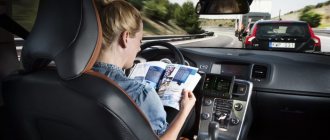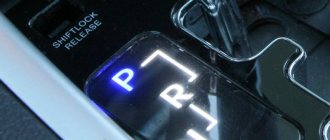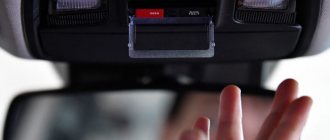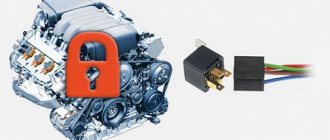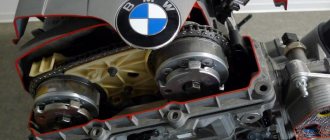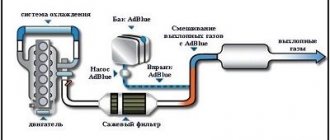Do you know what the overdrive button on an automatic transmission is for? For car owners who have a car with an automatic transmission, many buttons on the selector remain unused. They work only with the gear shift lever.
I often asked my friends and those who had their cars repaired by me what overdrive is on an automatic transmission. And I will say that only a fifth of those who have any kind of vehicle know the answer. But before you run to test this key on the machine in action, you need to find out what it is needed for and whether it is advisable to turn on Overdrive when traveling in urban conditions.
Why do you need Overdrive on an automatic transmission?
Car owners with a manual transmission know that fifth speed is an overdrive gear when the secondary shaft rotates faster than the primary. This speed helps save fuel consumption. The automatic does not have this speed, but there is a substitute. I hope many have already guessed what I am leading to?
Now you know what Overdrive is. This is an overdrive gear on an automatic transmission, similar to fifth speed on a manual transmission. But there are people who know that fourth speed is essentially an overdrive gear on an automatic transmission, and do not understand why they need to install a separate “Overdrive” function in the form of a button.
Attention! The transition to overdrive for vehicles with manual transmission begins at 80 km/h, and for automatic transmissions this transition occurs upon reaching 50 km/h.
For example, when driving on the highway, the car needs to accelerate and gradually shift gears from first to fourth in order to switch to an overdrive gear. This will force the engine to consume more fuel than if the button on the machine were turned on.
Read
Causes of the malfunction and what to do if the reverse gear on the automatic transmission is lost
When you press “Overdrive,” the donut lock is immediately activated, and the box shifts into overdrive. The automatic machine no longer needs to switch speed after speed to switch to the desired mode.
From here we will conclude that Overdrive is needed:
- while driving on the motorway;
- when the vehicle moves for a long time at the same speed (above 50 km/h);
- for driving at high speeds.
Accordingly, it saves fuel consumption and makes movement comfortable. In fact, Overdrive on an automatic transmission is analogous to fifth gear on a manual transmission.
How does turning on O/D affect vehicle dynamics?
When overdrive is turned on, it stifles the dynamics of the car, trying to reduce fuel consumption and save the life of the engine and transmission. In normal operation - city, highway, dirt roads in villages, light off-road - the dynamics of the car are not particularly important. Moreover, budget cars are not bought to be driven.
Cars with automatic transmission generally accelerate worse; they are chosen for their comfort in traffic jams. Frequent owners of “Grant” with a machine gun are elderly people and girls. For those who like fast acceleration for the same price, it is better to take a closer look at used Japanese cars. They are faster, more reliable, and look better.
Overdrive mode on automatic transmission, how to use
Well, now we can move on to the practical part. However, before you do this, did you know what the flashing “O\D Off” sign means on the dashboard monitor?
If you didn’t know, then you shouldn’t press the “OverDrive” button on the machine. The fact is that when this inscription appears, the car owner, even if he really wants to, will not be able to turn on the “OverDrive” mode. Since the ECU of the box, in order to preserve the health of the machine, blocks it from human influence.
Do you know why the car’s electronic computer does this? Let's look at the instructions for using Overdrive on an automatic machine and under what conditions it should not be pressed.
- When accelerating on the highway, press the button on the selector. Overdrive helps you not to change gear after gear on an automatic transmission, but immediately sets it up.
- When moving in the city, press the button again. Although now many mechanics will say that I’m wrong, because in city mode there are a lot of stops, which means a drop in speed. Accordingly, constant switching on will only kill the machine. My answer is that these mechanics are wrong. Why?
Read
Automatic transmission aisin A340E AW 30-40LE: oil change and valve body maintenance
Because the function can automatically turn off and does not require any action on the part of the driver to turn it off. Accordingly, to save fuel on long stretches of road without traffic jams or traffic lights (if you live in a metropolis or just a big city), turning on the mode will be useful.
Now you know how to use the “Overdrive” button on the automatic transmission. Let's look at when it shouldn't be turned on.
Features of the functioning of the 4th century automatic transmission.
The automatic transmission allows you to change the gear ratio along with the speed of the vehicle without driver intervention.
The range selection lever has an alphabetic and numerical designation. This type of transmission has a long service life. Also, it allows you to effectively slow down and restrain vehicles on an ascent or descent. When O/D is activated, the automatic transmission shifts sequentially from 1st to 4th gear. Overdrive mode blocks 4th gear, the car moves only in 3rd. At the same time, rapid acceleration is noted. Overdrive can be considered an analogue of the 5th gear of a standard manual transmission. When it is turned off, the O/D off message will light up on the instrument panel.
Switching to 4th occurs while driving, when the speed begins to exceed 45 km/h. When overdrive is turned on, when acceleration occurs, the transmission will sequentially shift from first to fourth gear, after which the torque converter lock-up is activated. As a rule, it is not possible to travel around the city at a constant speed. This is due to the fact that you have to stop frequently at traffic lights.
When to turn off Overdrive
Overdrive should not be used when there is no need to accelerate. For example, a vehicle may reach high speeds when towing a load. In this case, turning on the mode will only damage the box.
I also do not recommend turning it on in the following cases:
- long descents and ascents;
- during traffic jams and heavy traffic around the city;
- on country and dirt roads;
- while overtaking.
Attention! There is a lot of controversy about turning on Overdrive while overtaking. I will say this: under no circumstances! Arguments: enabling this function requires removing your hand from the steering wheel, thereby creating the danger of an emergency. If the car owner is a novice, he can bring the engine speed to the red line, thereby killing the device.
Is it worth deactivating OverDrive mode in the city?
I already wrote about this in the previous block. This block is a small addition for beginners who will rush headlong to use the function in urban environments in order to save fuel.
Use the Overdrive function on the automatic in the early morning hours or at night when there is no one on the roads. But in traffic jams or a string of intersections with pedestrian crossings, turning on 5th speed in the city is not recommended at all.
Switching to Overdrive on an automatic and then suddenly pressing the brake pedal will wear out the torque converter in the box. Often turning a key on and off leads to a breakdown of the machine.
Read
Reasons for automatic transmission slipping when shifting
Reviews
Opinions about this innovation are raging very different, some are “for”, some are “against”. Let's try to figure this out.
| Positive | Negative |
| When I drive at high speed, the speed in the automatic transmission drops and the ride becomes more comfortable and confident. | In my opinion, this is simply the most unnecessary function in an automatic transmission. It can only be used during intense overclocking. |
| It was not invented to cut speeds of less than 90 km/h. Golden thing! | When the OD is turned off, the car will not travel above 135 km/h, because there is a limit. |
| When OD is turned off, gasoline consumes much more. So I try to use it more often when possible. | Generally an unnecessary thing, just constant jerks with these on and off switches. It's impossible to drive in the city, don't even try. |
| I always turn on the OD at around 80-90 km/h and during further acceleration. | In the morning in traffic jams - murder with this function. |
| I really like it, the driver has more than one year of experience. Helps in many situations. | Another thing not invented for our roads. |
| I drive it (OD), and the box just flies, and hasn’t broken yet. | There is a very high probability of getting into an accident, since the car slows down with the OA on, the car is much worse. |
| For those who love fast driving - this is just right! | I don’t know, maybe it will be useful on the highway, but in the city I don’t see the point. And he saves crumbs. |
If you do not want to use this mode, then we will tell you a secret that you will not lose anything. This mode is a service assistant and is completely optional. You and your car will not lose anything if you never turn it on during its entire lifespan. But for more experienced drivers, sometimes this element becomes an indispensable thing!
OverDrive mode and fuel consumption
Now many will say that the difference in fuel consumption is insignificant and you don’t need to use the Overdrive button on the gearbox. Yes, in urban conditions the driver decides whether he should use this button or not.
But on the motorway, fuel consumption increases without the button on. Therefore, you can try everything: drive without Overdrive and see what the consumption will be. And then press the button and measure the amount of gasoline or diesel consumed.
As far as I remember, you shouldn’t count on strong savings. In this case, it is better to buy a car with a CVT transmission. Such cars are designed for city traffic and are economical, unlike gluttonous automatic machines.
Have you already tried the Overdrive mode on the machine? Can you write in the comments how much fuel you saved?
Why doesn't the Overdrive button work?
The Overdrive button on the automatic transmission may fail. For example, when the mode is on, the screen on the dashboard does not display information that Overdrive is on. But if the button is turned off, the light comes on.
If pressing the button does not extinguish the “O\D off” signal, then the key is faulty. Reasons for failure:
- physical wear of the button;
- the life resource has run out;
- poor contact;
- broken wires;
- gearbox is faulty.
In the latter case, you need to contact a service center for diagnostics as soon as possible. You won't be able to check it yourself. You will need a scanner and special software. Therefore, if it is impossible to turn on the key, contact experienced mechanics at the service station immediately.
MPRT or GtG response speed?
You'll also notice that some monitor manufacturers also include a 1ms MPRT (moving picture response time) specification. This is not the same as GtG response time. Instead, MPRT indicates that the monitor has motion blur reduction technology that uses backlight strobing to reduce perceived ghosting.
The problem occurs when a monitor manufacturer states that a display has a 1ms MPRT speed but does not show a GtG response time, misleading potential users that the monitor has a 1ms response rate when in fact the GtG response time may be 4-5 ms.
Motion blur reduction provides CRT-like motion clarity, but has its downsides: it reduces the monitor's maximum brightness when active and causes screen flickering—it also cannot work simultaneously with VRR (variable refresh rate) technologies such as FreeSync. and G-SYNC on most monitors.
Some gaming monitors can use VRR and MBR simultaneously, such as the ASUS VG279QM display with ASUS exclusive ELMB-Sync technology.
How does the automatic transmission work when 4th gear is engaged?
When you press the button, the automatic transmission torque converter is blocked. The driver feels a slight jolt. You should not associate the push with going into Overdrive. The latter occurs due to blocking of the gas turbine engine.
Read
Resource of automatic transmission, mileage and service life of automatic transmission
If the car begins to brake, the “donut” is unlocked. After this, the downshift begins. The same thing happens when the speed decreases below 50 km/h.
Manu
Alternative names: Hold, ETC Snow, Snow, current gear lock switch. When pressed, the currently selected gear is blocked from downshifting or upshifting, and a warning lamp in the instrument cluster lights up.
The button can be used in conjunction with the “D” mode and a manually selected gear – values 1, 2, 3, L on the mode scale.
In the first case, the car will start from 2nd gear. This will avoid slipping on ice and snow. In the second case, it makes it easier to climb/overtake and allows you to effectively use engine braking on steep descents, preventing overheating of the brake system elements and saving their life.
Advantages and disadvantages of the “OverDrive” mode
Before we start talking about the positive and negative sides of the mode, I want to know what Overdrive mode means to you. Has this button brought any changes to the way you drive your car? Write in the comments.
Now let’s talk about the advantages of Overdrive on an automatic transmission:
- wear and tear on the automatic transmission and vehicle engine is reduced due to the fact that the device does not have to constantly switch from one gear to another;
- There is a certain comfort during the trip. The driver feels as if the car is sailing, and not due to the engine and wheels;
- the power unit operates smoothly at low speeds when overdrive is turned on;
- fuel consumption decreases.
However, there are also disadvantages to this button. They are more significant than the positive features of the regime.
- impossibility of use in a populated area;
- Many machines are not equipped with a mode off key. This box has automatic mode change. Therefore, at high speed for a short time, Overdrive turns on independently;
- Based on the previous point, constant changing of modes leads to regular switching on and off of the donut. This has a bad effect on the torque converter and, in general, on the entire box. We'll talk about this a little more below;
- On slippery roads or snowy areas, the Overdrive mode on the automatic will make it more difficult for the vehicle to brake. Emergency situations cannot be excluded.
Regular turning on and off of the torque converter leads to rapid wear of the machine components. The oil overheats, loses its chemical properties faster and does not serve as a lubricant and wear protection for mechanical parts.
Read
Design and principle of operation of a hydromechanical gearbox
What can you say about the advantages and disadvantages of this mode?
Overdrive in the city
Should you use a higher gear when traveling within the city? The opinions of experts here are divided, and the arguments of both sides sound quite convincing and reasonable, so you will have to make a decision on your own.
Proponents of turning off this mode explain their position as follows: road conditions in modern cities are such that it is impossible to move at a uniform and relatively high speed for any length of time. This is hampered by dense traffic and the presence of adjustable traffic lights, which greatly influence the speed limit on certain sections of the road. This means that the box has to constantly switch, and when the mode is on, this will lead to frequent locking of the torque converter. And this means accelerated wear of this unit and an increase in fuel consumption that occurs out of the blue.
Adherents of using Overdrive believe that the last argument of their opponents is untenable. The point is that, regardless of whether the O/D button is turned on or off, the automatic transmission will still have to use frequent gear changes. And in this case, fuel consumption will certainly increase compared to driving on the highway, regardless of the time of year and the preferred driving style of the car owner. Therefore, even a short-term upshift will help save fuel.
Overdrive analogue
Overdrive has no analogues. Although many beginners confuse kick-down with overdraw. In general, the modes are similar. I do not recommend that car owners who do not have driving experience use this key. Since such drivers can not only damage the car, but also create an emergency situation on the road.
Attention! Advice for beginners. It is better to use the services of an on-board computer if you are driving a car with an automatic transmission for the first time. Since you do not yet have developed skills for experienced driving.
And also, beginners should remember that overtaking or other maneuvers can only be done if you have fully predicted the situation on the road. If the person driving is not sure that he can change lanes, or sees a large concentration of vehicles ahead of him, then it is better to stay in the same lane where he is.
Kickdown is only possible at low revs. The car enters this mode by completely pressing the gas pedal to the floor. Moreover, this must be done sharply and quickly. If you switch to this mode not in maximum gear, the speed will increase gradually, unlike Overdrive.
Which automatic transmission mode do you use most often when overtaking a car: kickdown or overdrive?
Designations on the box automatic Kia Rio - Let's go!
What do the letters mean?
P - (Parcking) parking, parking. Designed for long-term parking or stopping a car. You cannot set this mode until the car has completely stopped. If you park the car on a slope, put it on the handbrake first.
R - (Reverse) reverse gear. We also turn on this mode when the car comes to a complete stop.
N - (Neutral) neutral. Designed for towing cars. There is no need to shift gears to neutral while stuck in traffic jams, this is not a mechanic!
D or A - (Drive or Automate) forward movement of the vehicle. This mode is used for driving around the city, on flat roads. If there are no special conditions (snow, ice, slopes) you turn on mode D and forget about the gearbox for the entire trip.
L or B (or: l, 1, 1L) - (Low or Bottom) first gear. Used on ice, on steep descents and ascents
ATTENTION: B (Block) may mean differential lock, do not turn it on while driving - read the instructions.
2 or 2L - forward movement, the transmission will not shift above 2nd gear. Used when driving on mountain, highly winding mountain roads.
3 or D3 - 3rd gear, the transmission will not shift above 3rd gear. It is turned on when driving on hills, where there are frequent ups and downs, and also if you have to stop often and if your average speed is not higher than 80 km/h.
4 or D4 - 4th gear. It provides automatic shifting from first to fourth gear. Under normal driving conditions, it is recommended to use it if your average speed is 100 km/h.
And there are buttons:
OD - (Over Drive) overdrive mode. The button is located on the side of the lever itself and turns on together with D3 mode. Many people don’t know what it is for. It disables overdrive and OD-off lights up on the control panel. For example, you are driving at a speed of 60-80 km/h and the car constantly switches from 3rd to 4th gear. To prevent this from happening, you turn on the over drive mode and calmly drive in 3rd gear without constant shifts. This will not harm the car and constant switching will not irritate you. But don't forget to turn off OD when you get up to speed!
M - (Manual) manual control. By turning on this button, you simply select a gear using + and - on the control panel.
S - (Sport) sports mode. Designed for driving at high speeds.
W (*) or Snow—(Winter) winter mode. Mode for driving on snowy roads - helps the car move smoothly on slippery surfaces
Attention! The possibility of permanent use of this mode should be checked with the manufacturer; on many cars this mode is intended for rare use, and prolonged driving in this mode can damage the automatic transmission.
E - (Economic) economical mode, movement is smoother compared to sports mode.
KickDown - “gas to the floor.” The mode is activated while driving when the gas pedal is “depressed” almost to the limit in the form of the floor of the car. There is a transition to one or two gears lower, the engine finds itself in the region of the most powerful revolutions. This mode is used for overtaking.
If you don’t see any letters on your box, don’t be alarmed, there are different types of automatic boxes! Be sure to read the instructions!
How do we get going?
1. Start the car in P (Parking) position.
2. Press the brake and move the gearbox lever to position R (Reverse) or D (Drive).
3. Then everything is as usual: gas - the car accelerates, speeds change automatically; brake - the car slows down (but remember that not all automatic machines support engine braking mode, so the braking distance of such cars is somewhat longer!!!
4. When switching the lever from one position to another, you must keep the brake pedal depressed.
5. After turning off the car (preferably before), set the lever to position P.
Rules for driving with automatic transmission:
- Do not allow wheels to slip.
- Do not tow other vehicles or attach a trailer.
- Do not push start the car.
- Do not engage neutral unless there is a serious reason (for example, towing).
- Do not violate the rules for towing a car with an automatic transmission. You can tow a car over short distances (up to 20-50 km) at low speed (up to 20-30 km/h).
Bon Voyage!!!
https://youtube.com/watch?v=XFP0PSC0vIc
